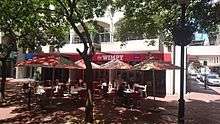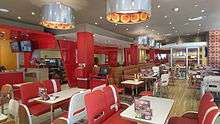Wimpy (restaurant)
 | |
| Wholly owned subsidiary | |
| Industry | Restaurants |
| Founded |
1934 in Bloomington, Indiana, U.S. 1954 in Coventry Street, London, UK |
| Founder |
Edward Gold (US) J. Lyons and Co. (UK) |
| Headquarters | Johannesburg, South Africa |
| Products | Fast food (Hamburgers, Chicken, French fries) |
| Parent | Famous Brands |
| Website |
www www |
Wimpy is the brand name of a multinational chain of fast food restaurants. The brand is currently headquartered in Johannesburg, South Africa. The chain originally began in 1934 in the United States and was based in Chicago. The brand was introduced to the United Kingdom in 1954 as "Wimpy Bar".[1] Wimpy grew to approximately 1,500 locations in several countries before narrowing to a few hundred locations in two to three countries. Wimpy's worldwide headquarters was located in the United States and the United Kingdom before relocating to South Africa.
Wimpy's menu consists primarily of hamburgers, chips (fries), breakfast items, and beverages.
History

Origins in the United States
The Wimpy brand was established in 1934 by Edward Gold, when he opened his first location in Bloomington, Indiana under the name Wimpy Grills.[2][3] The name was inspired by the character of J. Wellington Wimpy from the Popeye cartoons created by E. C. Segar. Gold did not open his first Chicago area location until two years later in 1936, after opening units in five other Midwestern cities.[4] By 1947, the Chicago Tribune reported that the chain had 26 units, and expected to sell eight million hamburgers annually in the Chicago area.[5]
According to a 1978 Chicago Tribune article, Gold's company Wimpy Grills Inc. of Chicago, had 25 locations in the United States at its peak, but only seven locations remained at the time of his death in 1977.[6] The chain vanished within the United States after Gold's death because no one had purchased the rights and trademark to the Wimpy name from Gold's estate.[6]
Wimpy's International
In 1954, Gold sold a license to J. Lyons and Co. to use the Wimpy name in the United Kingdom.[7][8] Wimpy Grills Inc. of Chicago later formed a joint company with Lyons called Wimpy's International Inc. in 1957. Wimpy's International was based in Chicago and allowed the brand to operate Wimpy Grills in the rest of the world.[9]
The joint company eventually grew to 1,500 locations, with Gold later selling his share to Lyons prior to his death.[6] After obtaining full control of the international licensing outside of the United States, Lyons and its successors handled global franchising through their United Kingdom-based subsidiary Wimpy International Ltd. This arrangement ceased when Wimpy UK became a subsidiary of the South Africa-based Famous Brands in 2007. The South African company started to handle worldwide franchising duties directly from Johannesburg.
United Kingdom
Lyons obtained a license to use the Wimpy brand in the United Kingdom from Edward Gold's Chicago based Wimpy Grills Inc.[7][8] and, in 1954, the first "Wimpy Bar" Lyons was established at the Lyons Corner House in Coventry Street, London.[10][11] Originally, the bar was a special fast food section within traditional Corner House restaurants, but the success soon led to the establishment of separate Wimpy restaurants serving only hamburger-based meals.
In a 1955 newspaper column, Art Buchwald, syndicated writer for the Washington Post, wrote about the recent opening of a "Wimpy's Hamburger Parlor" on Coventry Street and about the influence of American culture on the British.[11]
Buchwald wrote, "Food served at the table within ten minutes of ordering and with atomic age efficiency. No cutlery needed or given. Drinks served in a bottle with a straw. Condiments in pre-packaged single serving packets." In addition to familiar Wimpy burgers and milkshakes, the British franchise initially had served ham or sardine rolls called torpedoes and a cold frankfurter with pickled cucumber sandwiches called Freddies.[11]
During the 1970s Wimpy refused entry to women on their own after midnight. This may be because of an assumption they might be prostitutes.[12][13]
By 1970, the business had expanded to over 1,000 restaurants in 23 countries.[10]
In July 1977, the business was acquired by United Biscuits.[14] By the end of the 1980s, Wimpy was beginning to lose ground to McDonald’s, which had opened its first restaurant in the country in 1974, and so the new management of Wimpy began to streamline the business, by converting some of the traditional table service restaurants to counter service. When United Biscuits decided to divest its restaurant division in 1989, it sold the business to Grand Metropolitan (now Diageo). At the time of the sale, there were 381 locations in the United Kingdom. Grand Metropolitan had acquired Burger King the previous year, and it began to convert the counter service restaurants to Burger King since it had a greater global brand recognition.[15]
In February 1990, the remaining 216 table service restaurants were purchased by a management buyout, backed by 3i.[16] These were locations that were considered less desirable by Grand Metropolitan. At the time of the buyout, there were also 140 franchised locations outside of the United Kingdom. In October 1999, Wimpy rolled out a chain of restaurants known as Dr. Beaks, to take on brands such as KFC.[17]
A second management buyout occurred in May 2002, backed by the Bank of Scotland.[18] At the time of the sale in 2002, there were approximately 300 locations in the United Kingdom and Ireland.
Although Wimpy outlets have decreased in numbers in the United Kingdom, they are still found in many cities, and at seafront/seasonal locations, such as Clacton-on-Sea, Clarence Pier in Southsea, Porthcawl and Brean Leisure Park in Somerset.[19] By the beginning of the 21st century, most Wimpys were found in less desirable low rent locations that primarily cater to pensioners and others on a fixed income. This was a change as they were not in the former high street locations of their earlier days of the company.[20] Another big change from earlier times was that most locations were now franchises and not company-owned operations.
On 27 February 2007, Famous Brands, which owns the Wimpy franchise in South Africa, announced that it had acquired Wimpy UK.[21][22] Having acquired the brand, Famous Brands has rebranded Wimpy in the United Kingdom, to bring it in line with Wimpy South Africa. The "new" logo is actually the one used by Wimpy UK from the 1960s until the 1980s. In November 2009, Famous Brands began to upgrade its 170 locations in the United Kingdom to resemble United States-style diners.[23] By June 2017, only 80 restaurants remain in the United Kingdom,[24] down from over 500 during its height in the 1970s.[21]
South Africa



Wimpy International opened its first South African location in Durban in 1967.[25] The South African restaurants were sold to Bakers SA Ltd in the late 1970s, which in 1987 sold the South African chain to Pleasure Foods, then known as Juicy Lucy SA.[26] Famous Brands Limited, then known as the Steers Holdings Limited, acquired Wimpy when it bought Pleasure Foods in 2003.[27]
Famous Brands acquired the United Kingdom-based Wimpy in February 2007, thus becoming the parent company for the chain and beginning to collect the franchise fees from the other franchises.[21]
By 2011, Famous Brands had 509 Wimpy restaurants in South Africa, making it the largest franchise in the Wimpy franchise system.[28]
European expansion
France
In May 1961, French businessman Jacques Borel opened his first Wimpy restaurant in Paris after obtaining an exclusive franchise to operate Wimpy restaurants in France.[29][30] His restaurant was the first hamburger restaurant in France and had predated the opening of the first McDonald's restaurant by a decade.
By the end of that year, he was able to open three more locations within Paris. By 1966, he began to expand outside the capital, starting with Lille.[31] Within a short time, Borel had 20 locations; 15 in Paris and five in the rest of the country.[29] Although successful, Borel was forced to close the chain in 1969, owing to a disagreement he had with Lyons, the British parent company.[32]
Ireland
Wimpy has been in Ireland on two occasions, in the 1960s, and the early 2000s.[33] In the 2000s, petrol station chain operator Petrogas took on the master franchise for Ireland,[34] and had operated a large number of sites until 2010.[35]
Most have been replaced by Grill'n'Fill own branded areas, selling virtually identical products, or Burger King, for which Petrogas had obtained the franchise. Petrogas terminated its master franchise agreement with Wimpy International in 2010.[35]
Oceania
Australia
The Wimpy license in Australia was held by Happysnaks Pty Ltd and was owned by restaurateur and entrepreneur Oliver Shaul.[36][37] The first Wimpy bar opened in Sydney in November 1964, owned and operated directly by Happysnaks. Subsequent Wimpy bars operated as franchises.
By 1971, there were 70 Wimpy bars around Australia, the most successful being in Hindley Street, Adelaide.[38] Unable to compete with McDonald's, the Wimpy brand was withdrawn in 1975 and most Wimpy bars became independent fast food outlets.[38]
New Zealand
Wimpy had branches in New Zealand, including Auckland, Hamilton, Tauranga, Paraparaumu, Wanganui, Palmerston North, New Plymouth and Taupo. These were all rebranded in 2002. One store remained in Rotorua trading as Wimpy, although it was not part of the franchise chain. The last Wimpy in New Zealand was put up for sale in May 2008.[39]
Asia
India
Wimpy was one of the first fast food restaurant chains to open in India's free market economy. With a run of initial success, Wimpy was often touted as the first icon of 'Westernization' in India. A few of the restaurants which were still in business were located in Punjab until 2002.[40]
Israel
Wimpy entered the Israeli market in the 1960s, and for a time dominated the hamburger restaurant market.[41][42] Before its final failure and pullout in the 1980s, Wimpy was joined in an emerging market for hamburger restaurants by Burgeranch (since 1972) and MacDavid (since 1978). Wimpy was infamous in Israel for poor product flavor, and even for poor sanitation and hygiene; however, it did pioneer hamburger restaurants in Israel.[41][42][43]
See also
References
- ↑ Ellen Castelow. "Food in Britain in the 1950s and 1960s". Historic UK. Retrieved 16 July 2018.
- ↑ "Kennedy Ignores Flap Over Book: Edward V. Gold". Eugene Register-Guard. 16 October 1977. p. 6c – via Google News.
- ↑ Hoekstra, Dave (25 July 2004). "Pseudosliders". Chicago Sun-Times. p. 11. (Subscription required (help)).
Wimpy's, throughout the Midwest: Inspired by the Popeye's comic strip, J. Wellington Wimpy was a tubby character who always promised to "gladly pay you Tuesday for a hamburger today." Wimpy's started in 1934 in Bloomington, Ind., and even had outlets in Chicago's Loop. Founder Ed Gold died in 1978 while working in his Chicago outlet; his will stipulated that all his restaurants be permanently closed upon his death. That's moxie, not wimpy.
- ↑ "Restaurant Chain Enters Chicago with First Unit". Chicago Daily Tribune. 17 November 1935. p. 20.
Edward Gold, president of Wimpy Grills, Inc., operating restaurant units in five cities in the middle west, has leased for ten years the unimproved land at 117 East Chicago avenue... has started construction of the first of a chain of Chicago eating places.
Alternate Link via ProQuest. - ↑ "Restaurant Chain Leases Loop Site for New Building". Chicago Tribune. 20 April 1947. p. 3-B. Retrieved 8 August 2015.
- 1 2 3 Lazarus, George (28 July 1978). "Wimpy's for sale; is there 2d Ray Kroc?". Chicago Tribune. p. D9. Alternate Link via ProQuest.
- 1 2 "Edward V. Gold, 'Wimpy' Entrepreneur". Washington Post. 17 October 1977. p. C6. (Subscription required (help)). Alternate Link via ProQuest.
- 1 2 "Edward V. Gold, 70, the Founder Of the Wimpy's Restaurant Chain". New York Times. 16 October 1977. p. 42. (Subscription required (help)). Alternate Link via ProQuest.
- ↑ "Restaurant Chain Formed". New York Times. 5 April 1957. p. 50. (Subscription required (help)). Alternate Link via ProQuest.
- 1 2 "Wimpy Moments". Archived from the original on 28 March 2010. Retrieved 1 July 2010.
- 1 2 3 Buchwald, Art (5 June 1955). "Europe's Culture Falls to Hot Dog". Washington Post. p. E3. (Subscription required (help)).
We received a bulletin announcing Lyons Corner House, Ltd., the backbone of Great Britain's gastronimic empire, had opened a "Wimpy's Hamburger Parlor," right plumb in the center of Coventry st.
Alternate Link via ProQuest. - ↑ Roberts, Michele (15 March 2012). Paper Houses: A Memoir of the 70s and Beyond. Hachette UK. p. 37. ISBN 9781405516563 – via Google Books.
- ↑ Sandbrook, Dominic (9 April 2013). "What if Margaret Thatcher had never been?". BBC News.
- ↑ "Lyons Sell Last Of Wimpy". The Glasgow Herald. 9 July 1977. p. 11 – via Google News.
- ↑ "Burger King swallows Wimpy". The Herald (Glasgow). 8 August 1989.
- ↑ "Grand Met To Sell Part Of British Wimpy Chain". Chicago Tribune. 7 February 1990.
- ↑ Acland, Holly (14 October 1999). "Wimpy rolls out Dr Beaks chain to take on KFC in fast food". campaignlive.co.uk. Retrieved 28 March 2017.
- ↑ Mills, Lauren (26 May 2002). "Wimpy on buyout menu for £20m". Daily Telegraph.
- ↑ "Restaurant Locator". Wimpy UK.
- ↑ MacInnes, Paul (31 January 2002). "Lunch is for Wimpys: There's no longer one on every high street but the original British burger chain is still serving Big Benders - and making a comeback". The Guardian.
- 1 2 3 Clark, Ashley (29 April 2014). "The Slow Death of Wimpy, a British Institution". Vice.
- ↑ West, Edward (28 February 2007). "South Africa: Famous Brands Bites Off 75 Percent of Wimpy UK". AllAfrica.com.
- ↑ Golding, Amy (24 November 2009). "Wimpy to restyle its burger bars as American-style diners". Marketing Magazine. (Subscription required (help)).
- ↑ "Restaurant Locator". Wimpy UK. Wimpy UK. Retrieved 12 June 2017.
- ↑ Tassiopoulos, Dimitri (2008). New Tourism Ventures: An Entrepreneurial and Managerial Approach. Juta and Company Ltd. pp. 92–93. ISBN 9780702177262 – via Google Books.
- ↑ Maas, Carié (2013). From Corner Café to JSE Giant: The Famous Brands Story. Tafelberg. pp. 162–163. ISBN 9780624056799 – via Google Books.
- ↑ "Steers buys Pleasure Foods". Fin24. 19 August 2003.
- ↑ Vallie, Annaleigh (12 October 2011). "Wimpy helps Famous Brands reach 2000 milestone". Business Day (South Africa).
- 1 2 "Il y a 50 ans, le premier restaurant de hamburgers en France" [It is 50 years old, the first hamburger restaurant in France]. La Dépêche (in French). 29 May 2011.
- ↑ "Anniversaire Le premier restaurant de hamburger à Paris, c'était il y a cinquante ans: "Wimpy", fast-food éphémère" [The first anniversary of hamburger restaurant in Paris, it was fifty years ago: "Wimpy", fast food ephemeral]. L'Est Républicain (in French). 30 May 2011.
- ↑ "France: The Snack v. La Grande Cuisine". Time. 6 May 1966. (Subscription required (help)).
With a contract from the British-owned Wimpy chain, he opened his first four hamburger havens in Paris in 1961 and proceeded to lose money for two years. But gradually the idea of "a complete meal on a round bun" caught on. Now Borel serves 60,000 meals a day in Paris, and sales will run to $15 million or $16 million this year. Next week Borel will open his first Wimpy outside Paris in Lille, and then he moves on to the gastronomic bastion of Lyon. By the end of the year there will also be Wimpys in Nice, Bordeaux, Toulouse and Marseille, as well as five more in Paris.
- ↑ "Wimpy en France, en avance sur son temps?" [Wimpy in France, ahead of its time?]. ou-dejeuner (in French). 2 June 2011.
- ↑ "Old Adverts #52 – Wimpy, Dorset St, Dublin with Phil Lynott, 1968 – Brand New Retro". Retrieved 10 January 2017.
- ↑ "Wimpy International Ltd". Caterer Search. Retrieved 29 January 2008.
- 1 2 "Petrogas Annual report 2010" (PDF). Petrogas. 14 February 2011. p. 16.
During the year the Group decided to terminate its master franchise agreement with the Wimpy fast food brand.
- ↑ "First Wimpy Bar Open Here Soon". Sydney Morning Herald. 7 August 1963. p. 12.
- ↑ "First Wimpy Bar Open Here Soon". Melbourne Age. 7 August 1964. p. 11 – via Google News.
- 1 2 Doudle, Chris & Baldwin, Karen (2006). State of Mind: The Success Secrets of 50 South Australian Entrepreneurs. Wakefield Press. p. 35. ISBN 1862546843.
- ↑ Mihaka, Kelly (15 May 2008). "Rotorua icon Wimpy for sale". Rotorua Daily Post. Retrieved 7 June 2016.
- ↑ Mathai, Palakunnathu G. (10 January 2014). "Wimpy Fast Foods gets embroiled in legal battle involving charges of cheating, forgery". India Today. Retrieved 2 December 2015.
- 1 2 Rosenthal, Rubik (2007). הלקסיקון של החיים: שפות במרחב הישראלי [Lexicon of Life: Languages in Israel] (in Hebrew). Jerusalem: Keter. p. 118 – via Google Books.
וימפי המבורגר ישראלי משנות השישים, מבשר הפריצה המקדונאלדית
- 1 2 Segev, Tom. 1967 :והארץ שינתה את פניה [1967: The country changed its face] (in Hebrew). Jerusalem: Keter. p. 44.
׳וימפי׳ פתחה בארץ עוד ועוד סניפים, חברה בריטית לממכר המבורגרים שלא הצטיינו אמנם באיכותם, אך יחד עם משקה ה׳סנפרש׳ גם הם כמו שייכו את ישראל אל העולם הגדול.
- ↑ "???". Otot [Signal] (in Hebrew). Israel Association of Advertisers (209–214): 55. 1998.
״בשנות השבעים המוקדמות השם המבורגר׳ הוכפש על ידי המתחרה, וימפי, שהוציאה שם רע להמבורגר בגלל סניטציה, הגיינה וטעם לקויים. המבורגר, באותה תקופה, היה בן חורג של הפאסט פוד הלגיטימי, הפלאפל, והוא ניסה לפלס את דרכו ללא הצלחה.״
External links
![]()